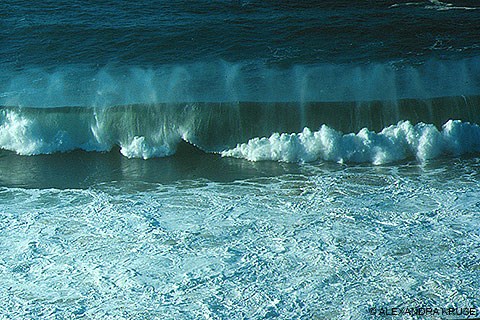
The National Park Service at Point Reyes National Seashore is charged with preserving the natural and cultural resources of this special place unimpaired for the enjoyment of future generations. This mandate of preservation extends to soundscapes (the sounds visitors hear). Natural and cultural sounds are considered resources or assets in the same way as the plants, wildlife, and historic structures. National Park Service policy requires, to the greatest extent possible, the preservation of natural soundscapes. Point Reyes National Seashore harbors over 490 species of birds, dozens of species of mammals, and thousands of insect species, all of which contribute to the Seashore natural acoustic environment. Point Reyes National Seashore also includes off-shore waters that are rich in marine life, including several species of whales and seals. The underwater acoustic environment is not easily experienced by us humans, but it is an essential habitat component for most marine mammals. Added to the sounds of the park’s wildlife are the sounds of prevalent physical process such as wind, waves, rock fall, and flowing water. Together, the natural sounds occurring in a habitat, at a particular time comprise its natural soundscape. A remarkable diversity of natural sounds occurs at Point Reyes National Seashore. From the crashing of ocean waves into rocky headlands blending with the call of common murres and oystercatchers to the sound of condensed fog dripping off the branches of Douglas fir trees, the richness of natural soundscapes is comparable to the Seashore’s wealth of habitats. Take an early morning stroll down the Bear Valley trail in June and you are sure to hear the songs of the Pacific wren, Swainson's thrush, olive-sided flycatcher, song sparrow, and many other birds against the backdrop of water flowing over sandy gravels and rocks in Bear Valley Creek. If you are lucky, you may even catch the call and hammering of the elusive pileated woodpecker. Traverse one of the Seashore's coastal prairie meadows in the evening and you may hear coyotes howling and elk bugling accompanied by a chorus of crickets. Point Reyes National Seashore also preserves a cultural landscape commemorating peoples enduring relationship with the landscape. Native Americans inhabited the peninsula for thousands of years. Dairy ranching has been a part of the areas for over 150 years, and the lighthouse and fog-signal on the headlands have been warning mariners of hazardous waters since 1870. Thus, the songs and chants of the Coast Miwok ceremonies at Kule Loko, the sounds of cows, and the droning of the fog-signal are a part of the Seashore’s cultural soundscape. Learn more about the sounds the NPS protects in Why Sounds Matter. While the natural soundscape is an important part of the park experience for many visitors, Congress did establish national parks to be enjoyed by the public. Therefore, sounds produced by human activity are often unavoidable. Roads, trails, facilities, visitors, and park operations represent sources of sound. And this creates a paradox: the people who visit national parks to enjoy the natural and cultural soundscape are directly or indirectly affecting the quality of the soundscape itself. Some people enjoy national parks using certain modes of access which affect park soundscapes. While viewing the park using an automobile, snowmobile, personal water craft, motorcycle, bus, or aircraft, noise is created which impacts other people who have an appreciation of natural sounds or an expectation of quiet and solitude, such as visitors exploring Wilderness areas. Adding to the difficulty of preserving the natural and cultural soundscapes unimpaired, people who use these modes of access are often not aware of the impact on other people and on wildlife. Perhaps the most extreme example of this is the use of air tours to visit parks. Other sources of noise originate beyond the park boundaries, and beyond the regulatory authority of National Park Service. These include aircraft overflights of a commercial or military nature. Distant highway traffic and motorized vehicles using adjacent public lands are other common sources of sound affecting a park. Human-produced sound not only affects the quality of the natural soundscape for the park visitor. It can also have impacts on wildlife. Nesting birds may be disturbed at critical times, reducing the success rate of hatching eggs and raising healthy chicks. The soundscape of an area is not just limited to the terrestrial environment. Underwater sounds can also be disruptive to marine species. At Glacier Bay National Park, analysis of underwater noise generated by fishing and recreational vessels indicated that these sounds disrupted the behavior of marine mammals. Marine biologists have linked mass strandings and deaths of marine mammals to sonar tests and exercises conducted by the Navy. Park visitors and managers must balance the enjoyment of a park with the protection and preservation of its natural soundscape. When visiting Point Reyes, be conscious of the level of human sound you create and how it may affect other visitors and wildlife. Find out how you can make a positive difference. MultimediaKQED's Quest Program: Soundscapes of National Parks - initially aired on September 28, 2009 Additional ReadingPark Science: Volume 26(3)--Winter 2009–2010: Special Issue: Soundscapes Research and Management Fox, D. 2020. Hush.... National Parks 94(1): 28–36. Available at https://www.npca.org/articles/2391-hush (accessed 29 May 2020). Learn More about Natural QuietScience & Research Project SummariesFrom 2006 to 2018, Point Reyes National Seashore and Pacific Coast Science and Learning Center (PCSLC) staff and communication interns assisted scientists conducting research through the PCSLC and the San Francisco Bay Area Inventory & Monitoring Network to produce a series of Resource Project Summaries, one of which was about the acoustic environment and soundscape at Point Reyes. These one- to eight-page summaries provide information about the questions that the researchers hoped to answer, details about the project and methods, and the results of the research projects in a way that is easy to understand.
Soundscapes of the Seashore StoryMap |
Last updated: March 9, 2024
